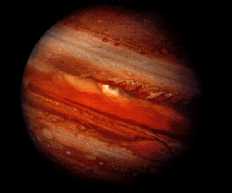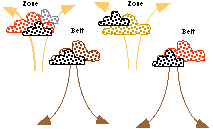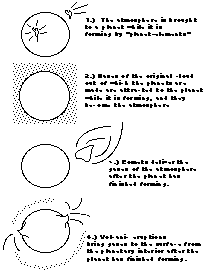This is a schematic showing how atmospheres form.
Click on image for full size
The Origin of an Atmosphere
There are four ideas for the origin of a planetary atmosphere. Those four ideas are 1. that the planet-elements of which a planet was made released the atmosphere, 2. that the atmosphere was drawn to the planet from the gaseous cloud out of which everything came, 3. that comets hit the planet and brought molecules of air with them, 4. that volcanos erupted and made an atmosphere from gases inside the planet.
The one that applies to Jupiter is hypothesis #2, in which the original material, which Jupiter drew out of the primitive nebula stayed, and forms the atmosphere today.
You might also be interested in:

As shown in this picture, while they were forming in the solar nebula, the nucleii of the planets-to-be (called protoplanets) drew material to themselves from the cloud of gas and dust around them. The
...more
The giant planets have definitely changed since their formation. But how much remains to be seen. Most of the original air of the giant planets remains in place. (The earth-like planets lost most of their
...more
The mesosphere of Jupiter is a region of balance between warming and cooling. That essentially means that nothing happens there. Except for diffusion, the atmosphere is still. Upper reaches of the atmosphere,
...more
As on Earth, the atmosphere of Jupiter consists of a troposphere, stratosphere, mesosphere, and thermosphere. The troposphere is the region where the visible clouds are to be found. The stratosphere, as
...more
The stratosphere of Jupiter is a region of warming as determined by infrared measurements of methane (CH4) in the region. Like the troposphere, the stratosphere is warmed by the sun, warmed by Jupiter's
...more
The troposphere of Jupiter is where the clouds are. Clouds form in regions of strong atmospheric motion, when condensation takes place. The troposphere is the region rapidly stirred by vertical motions.
...more
On Jupiter, the winds in the belts and zones blow first in one direction, then in the opposite direction. Wind blows east in a belt, and west in a zone. The clouds rise up in a belt, and drop down in a
...more















